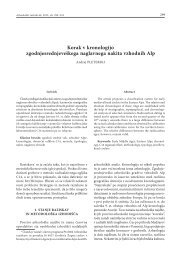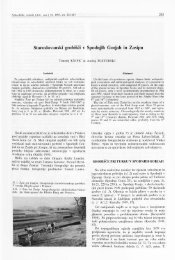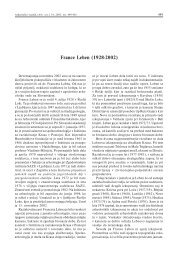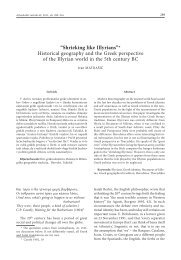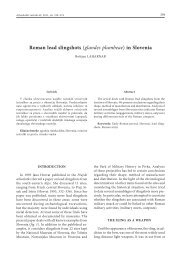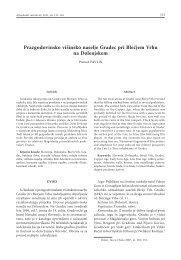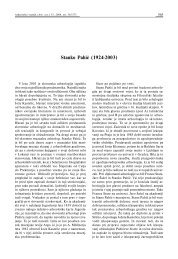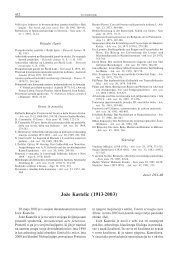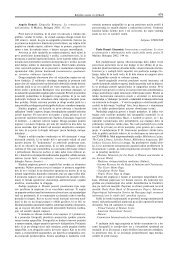Arh. vest. - Arheolo?ki vestnik - ZRC SAZU
Arh. vest. - Arheolo?ki vestnik - ZRC SAZU
Arh. vest. - Arheolo?ki vestnik - ZRC SAZU
You also want an ePaper? Increase the reach of your titles
YUMPU automatically turns print PDFs into web optimized ePapers that Google loves.
420 Knjižne ocene in prikazi<br />
at Ptuj Castle (9th-10th century), in which a large golden<br />
male ring was discovered, tentatively ascribed by the author<br />
to a high dignitary in the circle of Prince Kocelj (P. Korošec,<br />
Prispevek k izpovednosti velikega moškega zlatega prstana z<br />
grajske nekropole v Ptuju, Razprave Filozofske fakultete, 1997).<br />
Two volumes of Carniola archaeologica, the series of the<br />
Museum of Lower Carniola in Novo mesto, have appeared<br />
in these years. B. Križ published four barrows (two in each<br />
volume) from the largest tumulus cemetery in Novo mesto,<br />
called Kapiteljska njiva, where a flat cemetery of the La Tène<br />
period has also been discovered (B. Križ, Novo mesto IV:<br />
Kapiteljska njiva. Gomila II in gomila III, Carniola Archaeologica<br />
4, 1997; Novo mesto V: Kapiteljska njiva. Gomila IV in gomila<br />
V, Carniola Archaeologica 5, 2000).<br />
The Museum of Lower Carniola in Novo mesto and the<br />
Municipal Museum in Ljubljana organized several important<br />
exhibitions, accompanied by catalogues offering new information<br />
and/or new archaeological material. The first was “Novo mesto<br />
before the Illyrians”, presenting archaeological remains from<br />
Novo mesto (mainly from the site of Mestne njive) from the<br />
Urnfield Culture period, i.e. from the end of the Bronze Age,<br />
when large groups of a people (unknown by name) arrived<br />
to settle the Novo mesto region (B. Križ, Novo mesto pred<br />
Iliri / Novo mesto vor den Illyrern, 1995). This was followed<br />
by an exhibition presenting pottery and the development of<br />
its production in the Lower Carniola region from prehistory<br />
to the present day (I. Križ et al., Od antičnega vrča do majolke.<br />
Katalog razstave / Vom antiken Krug bis Majolka. Ausstellungs<br />
Katalog, 1996).<br />
The Municipal Museum in Ljubljana presented two large<br />
exhibitions and published two corresponding comprehensive<br />
catalogues, one about the history of the Ljubljana region from<br />
the Stone Age through Roman Emona to early mediaeval<br />
Luwigana with its castle (B. Dirjec et al. (eds), Pozdravljeni,<br />
prednamci! Ljubljana od prazgodovine do srednjega veka / Ancestral<br />
Encounters. Ljubljana from Prehistory to the Middle Ages,<br />
1996). Two years later, an exhibition showed the urban<br />
development of the same region, beginning with the lake dwellings<br />
in the Ljubljana Marsh, and with a certain emphasis on pre-<br />
Roman and Roman Emona, but also including the mediaeval<br />
and modern town (T. Čepič et al., Poselitev ljubljanske kotline.<br />
Urbani razvoj Ljubljane / Settlement of the Ljubljana Basin<br />
- Urban Development of Ljubljana, 1998). The third exhibition<br />
was of limited scope and size, but its small catalogue presents<br />
some new bronze material from Emona in drawings and<br />
descriptions (I. Sivec, B. Dirjec, Iz Vulkanove delavnice. Bronasti<br />
predmeti, bogastvo Emone, 1998).<br />
The Šempeter funerary monuments are published in an<br />
important guide book with excellent photographs (V. Kolšek,<br />
Rimska nekropola v Šempetru. Vodnik / Römische Nekropole<br />
in Šempeter. Führer, 1997), while small guides have appeared<br />
for the following sites: Tonovcov grad near Kobarid, in the<br />
hinterland of Forum Iuli (Cividale/Čedad), a recently discovered<br />
and partly excavated late Roman settlement and Christian<br />
centre (S. Cigleneč<strong>ki</strong>, Tonovcov grad pri Kobaridu. <strong>Arh</strong>eološko<br />
Peter Kos, Andrej Šemrov: Rims<strong>ki</strong> novci in kontramarke iz<br />
1. stoletja / Roman Imperial Coins and Countermarks of the<br />
1st Century: Augustus-Traianus. Zbirka Numizmatičnega kabineta<br />
Narodnega muzeja 2. Situla 33. Narodni muzej, Ljubljana<br />
1995. ISBN 961-6169-00-9. 206 str., 78 tabel<br />
Numizmatični kabinet NMS hrani v svojih sistemats<strong>ki</strong>h<br />
zbirkah številne novce. Del teh, rimske republikanske novce<br />
sta leta 1990 avtorja Peter Kos in Andrej Šemrov že predstavila<br />
javnosti v knjigi Zbirka Numizmatičnega kabineta Narodnega<br />
najdišče. Vodnik, 1997; Tonovcov grad presso Kobarid (Caporetto).<br />
Il sito archeologico. Guida, 1997; Tonovcov grad bei Kobarid.<br />
Archäologischer Fundort. Führer zu den Ausgrabungen, 1997;<br />
Tonovcov grad near Kobarid. An archaeological site. A guide,<br />
1998); Ajdna above Poto<strong>ki</strong>, a late Roman settlement in Upper<br />
Carniola below Stol Mt. within the Karavanke Range (M.<br />
Sagadin, Ajdna nad Poto<strong>ki</strong>, Kulturni in naravni spomeni<strong>ki</strong> Slovenije<br />
190, 1997), as well as Mali grad at Kamnik, an important<br />
(early) mediaeval castle with a mint, at the site of which a<br />
late Neolithic settlement and an early Slavic cemetery have<br />
also been discovered (M. Sagadin, Mali grad v Kamniku,<br />
Kulturni in naravni spomeni<strong>ki</strong> Slovenije 191, 1997). Mušja<br />
Cave (Grotta delle Mosche) is an important Bronze and Iron<br />
Age cult site, which seems to have retained its significance<br />
even in the Roman period (M. Frelih, The Prehistoric Cave<br />
Sanctuary Mušja jama in Slovenia: an Entrance to the Reign<br />
of Hades?, 1997).<br />
Several interesting books were published by various other<br />
publishing houses outside the established archaeological series<br />
and archaeological institutions, such as an outstanding guide<br />
book to the hundred most important archaeological sites in<br />
Slovenia by I. Curk, titled “A Hundred Stories of the<br />
Archaeological Monuments” (I. Curk, Sto zgodb arheološ<strong>ki</strong>h<br />
spomenikov v Sloveniji, 1995). Another interesting item is a<br />
“Cook Book from Emona”, which contains, besides an<br />
introduction to the culinary habits of the Romans, many<br />
modernized Roman recipes as well (L. Plesničar Gec, B. Kuhar,<br />
Emona in rimska kuhinja. Apicijevi recepti za današnjo rabo,<br />
1996). In a booklet titled “Triglav Mt.”, A. Valič hypothetically<br />
related the importance of the notion of a triad among the<br />
Slovenians to the three-headed Slavic divinity reflected in<br />
the name of the mountain (A. Valič, Triglav. <strong>Arh</strong>eološ<strong>ki</strong> problem<br />
in vprašanja njegovih predstav. Prispevek k preučevanju prvotne<br />
staroslovenske kulture na območju jugovzhodnih Alp, 1997).<br />
A. Pleters<strong>ki</strong> studied the mythological background to the ritual<br />
of the enthronement of the Caranthanian rulers, comparing<br />
it to similar traditions in Ireland (A. Pleters<strong>ki</strong>, Mitska stvarnost<br />
koroš<strong>ki</strong>h knežjih kamnov, Zbirka zgodovinskega časopisa 17,<br />
1997). In the course of recent years, S. Pahič published the<br />
results of his important topographical researches in Slovenian<br />
Styria, covering all the archaeological periods, in several provisory<br />
publications, unfortunately lac<strong>ki</strong>ng a clear overview (S. Pahič,<br />
Dones<strong>ki</strong> k pradavnini Podravja; Naši kraji v pradavnini; see<br />
the subtitles in the Slovenian review). The last to have appeared<br />
is a significant contribution towards the better understanding<br />
of the reliefs which adorn the Šempeter funerary monuments<br />
(J. Kastelic, Simbolika mitov na rims<strong>ki</strong>h nagrobnih spomeni<strong>ki</strong>h.<br />
Šempeter v Savinjs<strong>ki</strong> dolini / Sepulchral Symbolism of the<br />
Mythological Imagery on Roman Tomb Monuments. Šempeter<br />
in the Valley of Savinja, 1998). The book in fact offers much<br />
more than that, since several other important archaeological<br />
monuments found in Slovenia and neighbouring regions are<br />
discussed and presented along with the Šempeter reliefs.<br />
Marjeta ŠAŠEL KOS<br />
muzeja 1. Rims<strong>ki</strong> republikans<strong>ki</strong> novci. V drugem zvezku kataloga<br />
sistematske zbirke Numizmatičnega kabineta predstavljata<br />
ista avtorja gradivo iz prvega stoletja. Objavljata 815 rims<strong>ki</strong>h<br />
imperialnih novcev od vladarja Avgusta do Trajana ter članov<br />
njihovih družin. Številka se zdi morda skromna, vendar so<br />
v pričujoči objavi zajeti le bolje ohranjeni novci oziroma od<br />
slabše ohranjenih le tisti, <strong>ki</strong> kažejo na nekatere numizmatične<br />
posebnosti, predvsem na kontramar<strong>ki</strong>ranje in polovičenje. Delo<br />
je dvojezično; z originalnim tekstom v slovenščini in prevodom<br />
Barbare Smith Demo v angleščini.



